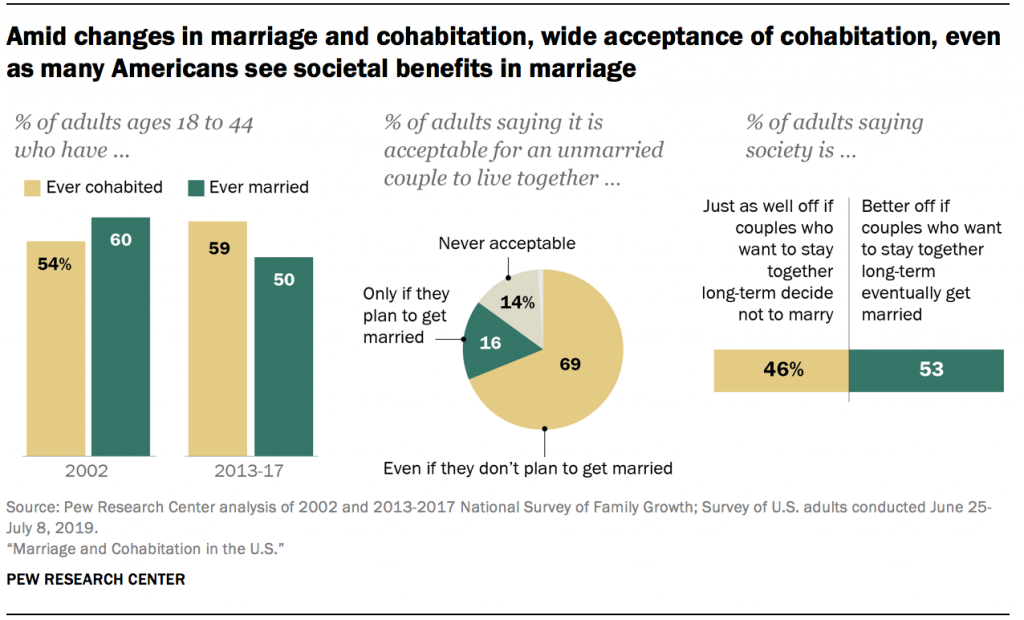Paths to Cohabitation
Introduction
Similar to the past, modern society is laced with paradigms about marriage and cohabitation. The paths to cohabitation are barely different from the path taken in the last half a century. Both men and women have the paradigms that they feel are the best for their marriage lives. On most occasions, their marriages are founded upon religion, personal belief, and other justifications that by far differ from the civil trails. As a result, most women, unlike men, suffer the consequences of failing to legalize their marriages. Research on cohabitation reveals the downside of the much-praised aspect of marriage.
The Case
The question of marriage by cohabitation raises several issues. Amongst them is the dispute of inheritance. According to Khan (2017), a marriage that is sanctified by religion is not recognized by law. It is especially so amongst the Muslims. When a woman is bereaved, she holds not a single right to her male counterpart’s property if their union was not recognized by law. Contrary to thought, she is not entitled to her deceased partner’s property. Her rights are only valid if the union was formal. Religious, tradition, and any other justifications of marriage are not recognized by law, at least not in the British Islamic system. Research on marriage reveals the paths of cohabitation in different cultures and their dynamics over time.
Since the advent of law, both men and women have embraced cohabitation from a falsified perspective. According to Jay (2012), a majority of women who cohabit with their male counterparts do it to improve their chances of a happy marriage. Similarly, a significant majority of men who cohabit with their female counterparts think that they stand a better chance of testing the quality of their relationship that will follow their marriage. It is for this and other significant reasons that both sexes prefer cohabitation to civil marriage. They believe that they are better off in a cohabitated marriage than they ever will be in a formally registered marriage.
A common paradigm is a belief in religion. According to Khan (2017), a majority of Muslim women believe that they are under the law’s protection upon engagement in religious marriages. They have the twisted belief that they can inherit their husbands’ property after bereavement or divorce. The opposite is sad, true. Marriage by religion is, in most countries, unrecognized by the law. Women are the victims of most situations. They find themselves juggling between lawsuits and hard life upon bereavement since they cannot inherit their deceased partners’ financial wealth. For this reason, cohabitation based on religious partnerships is unhealthy for women and their offspring.
The financial aspect of marriage is of great significance. According to Bauer (2019), men are better remunerated than their female counterparts. People within the same age brackets differ in remuneration based on their sexes. The death of men is, for this reason, a source of agony for their wives, who are mainly dependent on men’s financial contributions to their families’ welfare. Cohabiting is a central issue since it determines women’s ability to access their husbands’ financial assets. Contrary to expectations, women’s welfare in cohabitated marriages is not getting any better as times progress.
Analysis
The three articles agree on several fronts. Among them is the aspect of the perception of marriage. According to Khan (2017), a significant percentage of couples believe that there is no need to formalize marriages. Both women and men, especially amongst Muslims, support unregistered marriages. They, instead, prefer marriage by religion. The same happens across several other religions, such as amongst Anglicans, Quakers, and Jews. Marriage by religion seems to be gaining popularity, as opposed to formal marriages. According to Bauer (2017), both men and women fall into the trap of cohabitation due to the need to cater for bills. The economic perspective of partnerships is gaining traction, owing to the need to share expenses amongst partners. According to Jay (2012), most people who get into marriages by cohabitation think that it is a way of minimizing their risk of divorce. The perception of marriage amongst both men and women is that it is a way of avoiding relationships’ failure.
The functionalist theory suggests that marriages are part of society. In this sense, it postulates that marriage by cohabitation plays a role in society. Society would hardly be complete without this type of marriage (Craib, 2015). According to Khan (2017), marriage done through religious ceremonies minimizes the agony of going through the formal processes of divorce. For this reason, it helps both men and women to reduce the bureaucracy involved. Similarly, according to Bauer (2017), unregistered marriages minimizes the impact of income differences by leveraging the actuarially-equivalent amounts based on years. By so saying, the article posits that cohabitation minimizes the differences in wages with reference to the age of partners.
The conflict and symbolic internationalism theories are equally significant in the analysis of cohabitation marriages. The conflict theory posits that society is characterized by competition for resources (Craib, 2015). According to Jay (2012), time, money, and effort are amongst the main factors that lead to cohabitation. People seek to save them all at the same time, an issue that leads them into the trap of unwanted marriages. The symbolic interactionist theory posits that the meaning of marriage is ascribed to the societal meanings and beliefs (Craib, 2015). In this sense, the increasing preference for cohabitation marriages is a result of the decline in belief in formal marriage as opposed to religious marriages. Among the factors that are increasing the belief in the effectiveness of informal marriages are birth control methods, the sexual revolution, and the sharing of bills.
Conclusions
The paths to cohabitation in modern-day society are, in many ways, similar to the past. One of the aspects of comparison is the reverence to religion. Half a century ago, Muslims and people of other religions embarked on religious unions owing to their ease of action. In contemporary society, people still prefer religious marriages over formal marriages. Similarly, society has changed towards the preference of casual unions that are less inclined towards bureaucratic engagements. The need to minimize the processes of marriage and divorce raises the tendency towards less bureaucratic unions.
The effects of minimizing the agonies are, however, negative. Partners suffer, especially upon the demise of their counterparts. Women are the most affected lot. The law denies them access to the assets that their partners had, as well as what they accumulated during their partnership. For this reason, cohabitation deserves discouragement. People are, instead, encouraged to legalize their marriages for their benefit as well as the benefit of their marriage partners. The alternative for this is the development of policies and laws that favor people who are in unregistered marriages. The second remedy is, however, tedious and unlikely to happen in the foreseeable future owing to the bureaucracy involved in amending laws. Further research into the institution of marriage can, however, guide legislators in the development of more favorable policies and laws.








